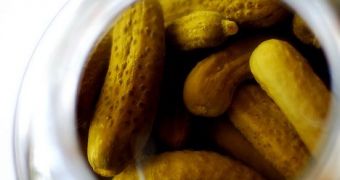Pickle spoilage bacteria that turns pickles red during fermentation may help environment by cleaning up dyes in textile industry wastewater, according to info from the US Department of Agriculture (USDA).
This new discovery was made by accident, as Agricultural Research Service (ARS) microbiologist Ilenys Pérez-Díaz was looking for the responsible of red spoilage bacteria on some commercial dill pickles.
Along with her colleagues, they isolated Lactobacilli from spoiled jars of hamburger dill pickles and put them into non-spoiled jars of hamburger dill pickles.
Pickle skins became reddish in jars that had brines with tartrazine, while those that had turmeric or no added coloring did not.
Pérez-Díaz found that adding sodium benzoate prevented bacteria from growing and the red-colored spoilage in hamburger pickles did not develop.
Scientists concluded that some species of Lactobacilli food-related microorganisms can cause red coloring when combined with tartrazine - a yellow food-coloring agent used for dill pickles.
The ARS researchers also found out that these spoilage Lactobacilli could have environmental benefits.
They observed that some Lactobacilli modify azo dyes, used in the textile industry can wind up in wastewater if untreated.
These azo dyes pass vivid and warm colors such as red, orange and yellow to fabric and even if many azo dyes are nontoxic, some can be mutagenic.
Pérez-Díaz says that a lot of effort has been made to establish which microorganisms can degrade azo dyes in wastewater, and if food-grade Lactobacilli capable of degrading a range of azo dyes were identified, they could become useful to treating wastewater.
This is the first report that food-related microorganisms can transform azo dyes into non-mutagenic substances and the results of this study have been published in the Journal of Applied Microbiology.
The Agricultural Research Service (ARS) is the main research agency of the United States Department of Agriculture (USDA), and one of four agencies in USDA's Research, Education and Economics mission area.

 14 DAY TRIAL //
14 DAY TRIAL //